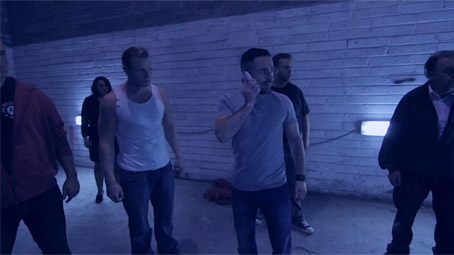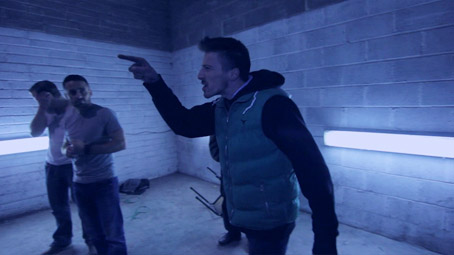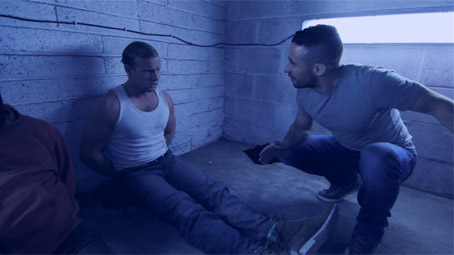|
Stop me if you've heard this one before.
A number of people that have never met before wake up in a room with no idea how they got there or why they've been abducted. Can they work together to escape their confinement or will they end up harming or killing each other?
As any schoolboy with a decent taste in film knows, that's the starting premise of Vincenzo Natali's superb 1997 thriller Cube and Andrzej Sekula's somewhat less impactful 2002 sequel, Cube 2: Hypercube. It's also the setup for French director Frédéric Grousset's intriguing, low-budget 2004 Aquarium, and pretty much all the films in the Saw franchise. Oh, and let's not forget Steven R. Monroe's House of 9 (2005), Simon Brand's Unknown (2006), Derek Osedach's Shadowplay (2007), Chris Shadley's Nine Dead (2010), and Christopher McQuarrie's TV series Persons Unknown (2010). And if you reduce that group down to a single bemused and desperate individual, you can also include Tsukamoto Shinya's criminally unseen Haze (2005), Franck Vestiel's visually arresting Eden Log (2007), Michael Winnick's Shadow Puppets (2007), Hitoshi Matsumoto's Symbol (2009) and a slew of others from both categories that I've no doubt are out there but have yet to fly onto my critical radar.
It's a great opening gambit, no doubt about it, but the problem for anyone heading down this road is that the film that kicked off this sub-genre is still far and away the best of the bunch. Cube got just about everything right, from the complexity of its puzzles and the interpersonal conflicts to the ingenuity required to navigate rooms that were all potentially lethal traps. And just when the characters and audience alike thought they had a handle on what was going on, Natali would simply shuffle the puzzle cards. Thus if you're planning to use this premise as the foundation for a mystery thriller, you're going to need a seriously smart new spin on the formula, and Natali didn't leave a lot of wriggle room here. Simply having the abducted individuals wake up and vent their fear and frustration by yelling at it other is not going to cut it.

So let's talk about Captive, the micro-budget second feature from Irish director Stephen Patrick Kenny, whose 2015 debut was the found footage horror The Pigman Murders. I would normally give you a plot outline here but I've already done so at the top of the page. Well, sort of. The difference here is that before any of the titular captives wake up, we're shown what is likely to happen to them later, that they'll try to kill each other until only one is left standing. Battle Royale, then. Oh, if only.
The year, we are assured, is 2021, so in just five years time this could happen to you. The early inference is that the whole thing is part of an alien experiment, which is why verbal instructions are delivered through a mobile phone in an almost incomprehensible electronic squawk, and why the text that beeps lazily across the screen refers to the captives as human subjects. And while the information in question is written in English (handy, that), it employs the sort of ugly angular font that filmmakers used to think looked futuristic back in the 1980s.
Gradually, each of the abductees awakes, and after the requisite expressions of confusion and fear they quickly move on to suspicion and accusatory shouts. Yet despite their desperation and the fact that they've woken in what looks to me like a bog standard warehouse, it takes some time for even one of them to think of trying the door to see if it's locked. We soon discover that any attempt to escape will likely get you killed, but they don't know that at this early stage. Well one of them seems to, as when one of his mouthier companions finally decides to give the very visible door a go, he is verbally and physically dissuaded from doing so.

Given that the one in the (possible) know was the first to wake up, we're encouraged to suspect that he might be a mole, though it's too early and the characters are too ill-defined and annoying at this stage to care all that much. Actually engaging with any of them proved to be a task that someone with my irritability threshold just wasn't up to. It doesn't help that by the time the characters in Cube had negotiated a handful of problems and revealed interesting and pertinent things about themselves, this petulant bunch were still standing around angrily shouting at each other. And not one of them is yelling anything worth hearing, just expressions of confusion and yobby proclamations like, "I'm sick of your shit!" and "You shut your FUCKIN' mouth before I kick it in for yer!" And it doesn't get better, even on the odd occasion when it genuinely looks like it will. It turns out they've all been infected with a lethal virus, you see, and when one of them falls victim to it and transforms into a feral zombie, the concept of trapping a group of panicky people in a room with a snarling monster got me briefly excited. It thus came as a bit of a let down when the humanoid threat in question just ran around for a few seconds before collapsing and dying. Oh well.
Names are exchanged, but the make-it-up dialogue and cast-your-mates delivery means they rarely register, to the point that each time the s-l-o-w-l-y typed textual readout confirms who the latest victim of the virus or interpersonal violence is, I rarely knew (or frankly gave a crap about) to whom it was referring, despite having just watched them expire on screen. And whoever is typing these textual messages can't seem to make up their mind how many dots to put at the end of each readout. For future reference, guys, the widely favoured number for an ellipsis is three...
It makes sense that the whole thing is shot in a hand-held, grab-it-as-it happens style, an approach that is nonetheless intermittently disrupted when director Patrick has an idea for an interesting or unusual shot, which while occasionally eye-catching rarely sits comfortably with the surrounding footage. There are also occasions when I couldn't help thinking the camera operator was in need of a sharp prod – "You've got to be fucking kidding!" proclaims one of group as he and his companion look anxiously off at something that the camera stubbornly refuses to pan round to show us. Not helping is a combination of location-recorded dialogue and a sound mix that prompts its delivery to jump violently up and down in volume and on occasion get swamped by a video game-style score, one that rarely feels married to the action it over-dramatically accompanies.

Most curious of all are the special effects, whose wide variance in quality suggests that each was executed by a different member of the film student body. The eyeballs that flick suddenly to white are impeccably done, but if you're going to add a smoke effect in post, then at least motion track it to the action so it doesn't follow the camera when it pans round. Someone was clearly pleased with their see-your-breath-in-the-cold effect, but it only appears in two static facial close-ups, which does make it feel like a showreel moment – there are certainly few other indicators that the warehouse is supposed to be close to freezing. The most jaw-dropping effect is saved for the final scene, and here I'm using that term in the pejorative sense. We all make allowances for budget restrictions, but in an age when even a couple of the writers on this very site are creating complex and convincing visual effects on their laptops using software costing less than £40, the blatant fakery of the money shot here made me wonder if I was meant to read the whole enterprise as parody.
Oh man. As regularly readers may be aware, I've a fondness for trashy horror of years past and low-budget thrillers that get by on little more than their energy and ingenuity, but I really, really struggled with Captive. Even the final reveal about what is going on, although interesting (but not original) as a concept is undermined by a couple of major credibility issues that I can't really discuss without delivering spoilers for those who still want to give the film a go, regardless of anything this idiot has said. After all, just because I didn't like it...
It seems likely that Captive was shot on domestic or semi-pro HD, an assumption given weight by the 1.78:1 anamorphic framing and the micro-budget aesthetic. The image is clean and well detailed for an SD transfer, though the familiar post-production tinkering with the colour has bathed the warehouse interior in a wash of blue that just takes the edge off the otherwise well-balanced contrast and nobbles some of the shadow detail, though not in a particularly harmful way.

The Dolby 2.0 stereo soundtrack has some problems, but it's hard to say which are down to the location sound recording, the original sound mix or the transfer to DVD. It does seem likely that some of the clarity issues are down to the sound recording – lines delivered off-camera, for example, do not appear to have been recorded at premium quality and mixed to feel like they are being delivered from a few feet away, but recorded live on a mic aimed squarely at an on-camera actor, pushing the off-camera dialogue some way into the distance. Occasionally, whole lines come close to being drowned out by the score or the angry babble of someone standing nearer to the sound recordist. As I mentioned above, there are also some sizeable jumps in the volume of the dialogue delivery, at one point mid-way through a sentence being delivered over a mobile phone speaker by one of the captors.
Short Film: Anchors (9:10)
An initially intriguing short directed by Michael Pearce with a couple of nicely quirky elements – the youthful Nazi who spreads his teachings through the power of dance is a lovely surrealist touch – but whose message, however honourable its intentions, is obvious and leads to an "is that it?" conclusion.
Theatrical Trailer (1:31)
A loud trailer peppered with anger, conflict and annoying electronic crashes.
What's left to say? As you've probably gathered, I didn't get on with Captive at all. If you've never seen Cube or its variable successors then you may well get more out of it than me, but if that's the case I'd still recommend you hunt out Cube instead. Left Films' DVD is an otherwise serviceable affair, but the uneven soundtrack does the film no favours, and I'm still not sure who to point the finger of blame at for the issues there.
|